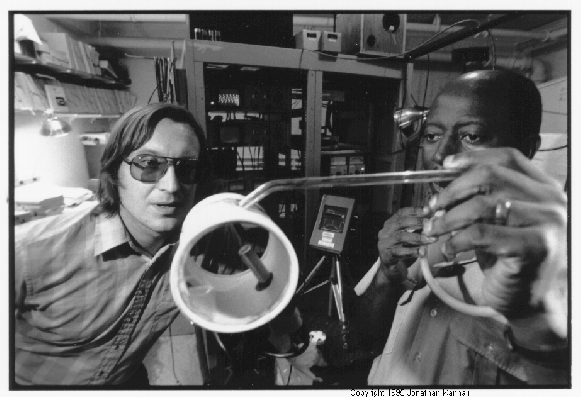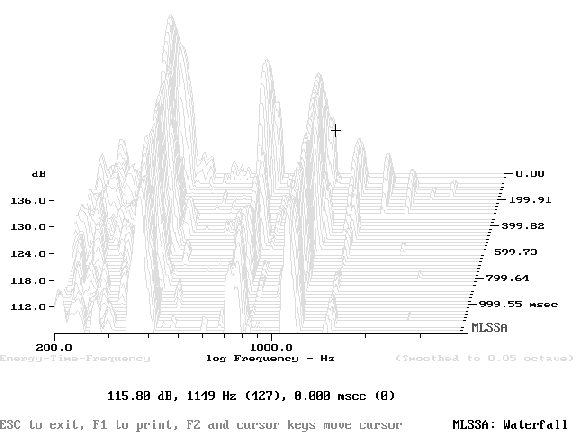Richard H. Campbell (508) 831-5701 - rhcamp@ece.wpi.edu
Electrical and Computer Engineering Department
Worcester Polytechnic Institute
100 Institute Road,
Worcester, MA 01609
Popular Version of Paper 3pAB10
Presented Wednesday afternoon, December 4, 1996
3rd Joint ASA/ASJ Meeting
Embargoed until December 4, 1996
We have all heard the expression that an "army travels on its stomach". But when an army gets sick, it stops. There can be many causes of disabling sickness and among the worst of them are those caused by mosquitoes. Thus the U. S. Army and its Walter Reed Army Medical Center (WRAMC) have an abiding interest in mosquitoes and maintain a staff of entomologists and support personnel to deal with this threat. When the army is deployed in the field an entomologist collects bugs of all kinds to investigate what disease vectors exist and, therefore, what preventative measures to take and what vaccines to administer.
It is known that different mosquito species are responsible for carrying different diseases. Prior research has shown that the wing beat sound of female mosquitoes is different for different species. In fact, that is how the male differentiates the swarming females for mating purposes. If it were possible to determine which species of mosquito existed in a place by recording and analyzing their wing beat sound it could save a great deal of time by avoiding either sending specimens back to some laboratory for analysis or sending a trained entomologist to the site.
In 1995 the WRAMC initiated a contract with the Electrical and Computer Engineering Department Acoustics Laboratory at Worcester Polytechnic Institute to conduct research in the recording and analysis of mosquito wing beat sound. This research is still in progress however some interesting data have emerged which indicate that it may be possible to identify species from their wing beat sound using advanced signal analysis methods together with a reasonably good recording, or with a real-time flight in a suitable cage equipped with a microphone.
Another aspect of this research is in the design of mosquito sound traps. These have been fairly successful in the field even though they use simple sine waves emitted at specific female wing beat frequencies. They are used mainly by entomologists for field trapping and have not been commercially realized. With modern music synthesis techniques, it is now possible to generate extremely accurate species-specific female wing beat sound which simulates swarming flight and which should attract very large numbers of males. The fate awaiting them is auto-chemo-sterilization which, in the course of two weeks, can eliminate the species entirely over a wide area, preparatory to being occupied by humans.
It is not easy to record a mosquito in flight. The specimens are brought to the laboratory from the National Institutes of Health insectarium breeder, never having been in the wild and not carrying any disease. The recording cage is a one quart cardboard can with the ends removed and replaced with netting. There are two openings in the side of the can, each covered with stretched latex which has a slit made by a knife. The microphone is inserted through one slit to the center of the can. The entomologist selects a specimen from the transport cage using a pipette and gently blows it through the other slit into the recording cage as can be seen in the photo. The bug is encouraged to fly by exhaling into the cage (carbon dioxide is a mosquito flight stimulus).
 Copyright 1995, Jonathan Kannair
Copyright 1995, Jonathan Kannair
The DAT recording is sporadic because the bug flies only occasionally, the sound level is quite variable as the bug flies closer or farther from the microphone, and the timbre changes as the bug negotiates the cage interior with flight maneuvers and changing wing dynamics. The several-minute flight recording is then transferred to hard disk through a sound card and is edited using cut-and-paste routines familiar to sound engineers in a program called Sound Forge into a one-second sample of high-quality sound. All of this is done at a sample rate of 22,050 samples per second.
 Figure 1, Waterfall plot of female anopheles stevensi
Figure 1, Waterfall plot of female anopheles stevensi
These flight data are then transferred to another program called MLSSA which has a powerful FFT waterfall display routine so that we can now see the one second flight record in 3-D: time, frequency and level as seen in Fig. 1.
This program can export these data to yet another program called Mathcad which catalogs the flight data in terms of harmonics and also makes some decisions on rejecting poor data. We now have the time-frequency-level data in highly selected tabular form which can eventually be transformed into a set of commands for a sound synthesizer, or can be further analyzed for species identification.
This seemingly cumbersome process using commercial computer programs is only a research convenience. Ultimately this entire process will be collapsed into a microprocessor program running in a small computer.
Although sponsored by the U. S. Army, the civilian application of this research is significant, particularly with respect to trapping. In New England, the summer of 1996 was very wet with prodigious mosquito breeding. Near the Rhode Island-Massachusetts border an outbreak of eastern equine encephalitis terrified entire towns and triggered a massive and costly eradication program which took weeks to be effective. The authorities perceived the mosquito threat to be a greater evil than the spraying of hundreds of square miles with insecticide.
A future acoustical solution could elicit the following question from a little girl being driven home from school: "Mommy, why do those boxes hanging in the trees around the playground sound like bugs?"